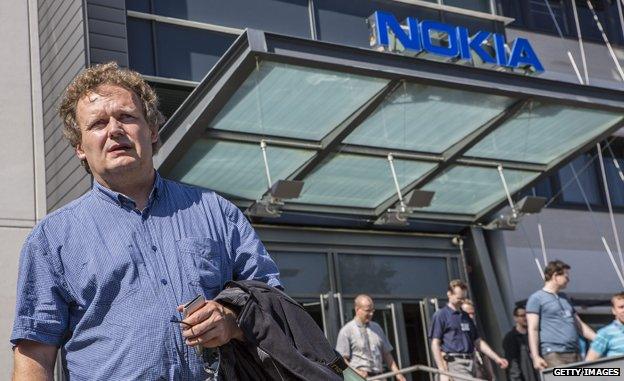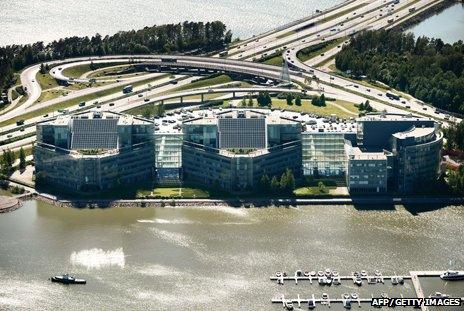The upside to being let go by Nokia
- Published

Staff leave a Nokia building in Finland in 2012, after a briefing to announce thousands of redundancies
During the years of Nokia's decline, culminating in the sale of its mobile phone division to Microsoft in September, thousands of workers were made redundant. But the ex-Nokians have now created hundreds of new companies - thanks partly to a very Finnish level of support from the employer to its departing staff.
Like many university graduates in Finland, Kimmo Koivisto only wanted to work for Nokia - the country's biggest and most successful company. He fondly recalls the four years he spent working in its research strategy team in Helsinki.
"Working for Nokia was my dream job. It was good fun, having the geek inside me enjoying all the geeky stuff that was happening," he says.
Nokia once dominated the worldwide mobile phone market. It also dominated Finnish life.
Up until 2012 it was Finland's biggest employer, with more than 24,000 workers at its peak in 2000 (and another 36,000 overseas). It had an operating profit of 8bn euros and accounted for 4% of the country's GDP.
But in 2007 Nokia found itself losing ground rapidly against Apple and Samsung, and their hugely successful smartphones.
By the end of 2013 the number of employees in Finland had fallen by over half to 10,600. Its operating profit in 2012 was minus 2.3bn euros.
Kimmo left Nokia of his own accord, but he says it has been hard for him to watch the company's change in fortunes.
"Nokia gave us so much. You really grew there, learning so much and taking the opportunities it provided," he says.
"Then, in a few years everything is disappearing. It's very sad and difficult to see that happening."
In February 2011 Nokia announced that it was replacing its operating system with Microsoft Windows. The company restructured, shedding staff.
But about the same time, the company launched the Bridge programme, a scheme offering financial help and training to the workers who were about to leave.
"The company decided - all the way from the board to the senior management - that we wanted to do career responsibility as well as we can, beyond what the legal minimum is," says Matti Vanska, the head of the Bridge programme.

Ex-Nokian Kimmo Koivisto (left) and Matti Vanska, of Nokia's Bridge programme
The scheme - available to 18,000 employees across 13 countries - helped people to find a new job, offered training for a completely new profession, or helped entrepreneurs set up their own companies.
In Finland 5,000 people received help and 400 new companies have now been created by around 500 entrepreneurs.
Kimmo was not eligible for Bridge funding because he left Nokia voluntarily. But he launched Tellyo - an app which allows people to instantly record and share TV clips with friends - with two other ex-Nokians who were.
Jakub Majkowski and Justyna Kowalska each received the maximum grant amount of 25,000 euros (£20,770) which was immediately invested in Tellyo.
Since it started up in January 2012, it has signed deals with broadcasters in Finland, Spain and Poland.
"The company would never have started without the Bridge programme," says Kimmo.

Nokia's headquarters in Espoo, near Helsinki
"We couldn't believe that you could get so much support. It was an unbelievably good opportunity."
Nokia is not prepared to reveal how much the Bridge programme has cost but says it is "in the tens of millions of euros".
Some new companies have - with permission - taken licensed technologies from Nokia. Others - like Jolla Mobile - have given new life to ideas which were no longer considered part of Nokia's strategy, such as the MeeGo operating system.
"We saw this perfect opportunity to take the people, the asset and the know-how to create something new," says Jolla's co-founder Marc Dillon.
Dillon had intended to work at Nokia for the rest of his life but was made redundant after 10 years working for the company in San Diego and Helsinki. The majority of Jolla's 90 employees also worked at Nokia.
Based in a former Nokia research centre in Helsinki, Jolla used elements of Nokia's MeeGo system to create a new operating system called Sailfish, and launched its first mobile phone in November.
Dillon says "agreements and things" don't allow him to say if his company received money from Nokia. But he says that Nokia is not an investor in Jolla.
"The most important thing was that they encouraged and they did not block. They could have said No, citing anti-competition or something like that.
"Instead we were open with them and they were open with us and we were able to take MeeGo and do something with it."
Another company that was allowed to take technology out of Nokia and develop it is PulseOn, which claims to have created the world's most accurate and easy-to-use sport heart-rate monitor.

Nokia has allowed some companies to use its technologies
PulseOn describes itself as being a Nokia spin-off company. Four out of its five shareholders are ex-Nokians, including Tero Mennander who spent five years heading a business development team.
"We saw a fantastic opportunity to commercialise a technology where the foundations were developed within Nokia," says Tero.
Nokia gave the company a grant of tens of thousands of euros, and helped arranged a credit guarantee from a bank.
The grant enabled PulseOn to fund itself for 10 months, allowing it to further develop the technology before getting venture capital investment. The company now has 13 employees and will launch its first commercial product this year.
"It would have been very challenging to start it from scratch," says Tero.
"We're extremely grateful that this opportunity was given to us."
Some may argue that Nokia has done all this for its ex-staff to generate good publicity. This is denied by Matti Vanska.
"We said the individual priority is first, the community priority is second and the Nokia interest is third. I believe that when you do the right thing, Nokia will also benefit - but that was not the primary driver."
Ari Tulla is another one who benefited. He was Nokia's Head of App studios, working in Helsinki and San Francisco, but opted to leave when Nokia decided to switch to the Windows phone in February 2011.
He and Tapio Tolvanen - who also took redundancy - set up a company called BetterDoctor in San Francisco. Its app allows users to quickly find a suitable local doctor based on their insurance plan and the type of care they need.
Ari says the Bridge programme gave BetterDoctor "a few tens of thousands of dollars" but believes the gesture was about far more than money.
"Nokia has been - and is still today - a Finnish company and if you think about the Finnish psyche, it's a very fair culture," says Ari.
"When we do something we always want to see it through. You don't see Finns bailing out, that's not part of the culture so I think you would expect that from Nokia.
"For workers in America, if you worked at a company like General Electric it's more like you get the package - a month's salary - and go. They lock the doors on the day you are fired.
"At Nokia there were people who knew they were going to be laid off in six months and they were able to stay at Nokia with a Nokia email address with the Nokia laptop and spend time applying for new things and Nokia helped them. That's pretty fair."
Follow @BBCNewsMagazine, external on Twitter and on Facebook, external